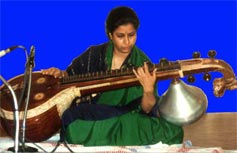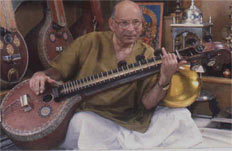VEENA
Veena the traditional instrument of India is also known as Saraswati Veena which is a musical instrument of South India. Veena is a classical instrument basically plucked stringed instrument that is used to accompany Carnatic music. Veena is essentially a member of the lute family.
The traditional Veena has been modified and refined over centuries and has been used since ancient times. During 17th century the Saraswati Veena was created in the south of India.
Veena instruments developed more like a tree which is branching out into instruments as diverse as the exotic harp-like Akasa (a veena that was tied up in the tops of trees for the strings to vibrate from the currents of wind) and the Audumbari veena (played as an accompaniment by the wives of Vedic priests as they chanted during ceremonial Yajnas). Veenas ranged from one string to one hundred, and were composed of many different materials like eagle bone, bamboo, and wood and coconut shells.

"The current form of the Saraswati veena with 24 fixed frets evolved in Thanjavur, Tamil Nadu, during the reign of Raghunath Nayak and it is for this reason sometimes called the Tanjore veena, or the Raghunatha veena. Prior to his time, the number of frets on the veena were less and also movable. The Saraswati veena developed from Kinnari Veena. Made in several regions in South India, those made by makers from Thanjavur in the South Indian state of Tamil Nadu are to date considered the most sophisticated. Sangeeta Ratnakara calls it Ekatantri Veena.
Each physical portion of the veena is said to be the seat in which subtle aspects of various gods and goddesses reside in Hinduism. It is believed that instruments neck is Shiva; the strings constitute his consort, Parvati. The bridge is Lakshmi, the secondary gourd is Brahma, the dragon head Vishnu. Upon the resonating body is Saraswati, the bridge Lakshmi. Thus, the veena is the abode of divinity and the source of all happiness according to Musicologists.
The Veena is an instrument which is shown being played by Goddess Saraswati. That is how the traditional Indian Instrument derives the name "Saraswati Veena". Popular variations of the Veena in India are Rudra Veena, Mahanataka Veena, Vichitra Veena and Gottuvadhyam Veena. The Veena has been a very popular instrument with most singers and there are many famous Veena players who have played some great compositions. The Veena is a traditional stringed Indian musical Instrument having number of variants. It is considered the instrument played by the goddess Saraswati. The Veena has a double base and is rested on the ground while it is played. It produces sound similar in character to the sitar but is favored by many because of its ease of playing style and its impressive designing.
How to play a Veena
TThe Veena is held tilted slightly away from the performer. One has to sit cross legged and place the Veena on the lap. A small gourd is placed on the left thigh of the player. The left arm of the Veena player comes curving from below the fret board and rests on the frets. The right hand is placed on the edge of the top plank in order to pluck the strings. The frets are played with the fingers of the left hand while the right is for plucking the strings. The lower strings are played using the little finger. The Veena produces a beautiful and enigmatic sound that is often used to relax the mind and help in meditation.Popular Musicians

- Doraiswamy Iyengar
- Jayanthi Kumaresh
- Kalpakam Swaminathan
- N. Muralikrishnan
- N. Ravikiran
- S. Balachander
- S.V. Venkateshiah
- Veena Dhanammal
- Veena Venkatagiriappa
- Veene Sheshann
Where to learn to play the Veena
TARANG School for Classical Indian Dance and MusicManager: Marie-Luise Siebenkaes
Johannisstrasse 14D-90763 Fuerth
Germany Telephone: +49-(0)911-6708040
Fax: +49 (0)1212-512616701 USt-IdNr.: DE228189973
Dr. Suma Sudhindra,
#42, Sirur Park Road, 4th cross,
Malleshwaram, Bangalore 03
Phone : Mobile: 9845044446
Land Line 1: 080 23466789
Land Line 2: 080 23561918
Where to buy a Veena
Sathyadeep Musical PalaceContact: Mr Ashish Shrivastava
Beside Vysya Bank
Post- Puttaparthy
Dist-- Anantapur
Andhra Pradesh Pin- 515134
INDIA
[email protected]
[email protected]
Ashish Shrivastava
Shyam, smriti apartment 6/79
Chitravathy road
Puttaparthy 515134
Andhra Pradesh
India
Tel- 0091 9440016942


